Real-World Data Shows Improved Responses for Pembrolizumab/Chemo in TNBC
A study of patients who received the KEYNOTE-522 regimen showed an improved pathologic complete response in real-world data vs what study data showed.
A study of patients who received the KEYNOTE-522 regimen showed an improved pathologic complete response in real-world data vs what study data showed.

Real world data accumulated from the regimen analyzed in the randomized, double-blind phase 3 KEYNOTE-522 trial (NCT03036488)—neoadjuvant pembrolizumab (Keytruda) with chemotherapy consisting of carboplatin, paclitaxel (Taxol), doxorubicin, epirubicin, and cyclophosphamide (Cytoxan)—demonstrated improved pathologic complete response (pCR) and a decrease in axillary node dissection (ALND) in patients with early-stage triple-negative breast cancer (TNBC), according to a study published in Annals of Surgical Oncology.1
Of 240 identified patients, 86 received the KEYNOTE-522 regimen, and 154 received the control regimen. Patients who received the KEYNOTE-522 combination demonstrated a pCR of 59.3% vs 33.1% of patients in the control arm (odds ratio [OR], .34; 95% CI, 0.20-0.58; P = .0001). No notable difference was found with regards to breast conservation therapy (BCT), 32.1% in the KEYNOTE-522 group and 33.1% in the control group (P = .47). The KEYNOTE-522 regimen elicited a significantly lower ALND rate than the control arm of 25.6% vs 39.6%, respectively (P = .03).
“[The KEYNOTE-522] regimen causes the cancer cells in the breast to respond in many patients with TNBC. We suddenly have a regimen that’s highly effective, and we had to adjust our approach accordingly,” Julie Lang, MD, professor of surgery and director of the Eastern Region of Cleveland Clinic’s Breast Cancer Program and chief of Breast Surgery at Hillcrest Hospital, wrote in an article published on the study.2 “…We hope that our findings will help other hospitals design appropriate treatment plans for their own patients as they, too, adopt this new regimen.”
Data from a total of 240 patients diagnosed with stage II or III TNBC who underwent neoadjuvant treatment followed by surgery at the Cleveland Clinic was gathered. Data groupings were separated by those who received the KEYNOTE-522 regimen (n = 86) and those who were a part of the control group (n = 154).1 The median age in the overall population (n = 240) was 56 years old; 66% of patients (n = 158) had T2 tumors; 83% (n = 200) were grade 3 via Nottingham grading score, 79% (n = 190) presented with a self-detected mass on presentation, and 46% (n = 110) had clinically involved lymph nodes at diagnosis.
All patients diagnosed with stage II or III TNBC between January 2019 and December 2022 who underwent neoadjuvant treatment and subsequent surgical intervention were enrolled in this study.
The primary trial outcome was to determine if the regimen was associated with higher pCR rates which would correspond with higher BCT rates. Key secondary outcomes were identifying factors associated with pCR, factors that influenced surgical procedure types, and what the effect of the regimen was on efficacy outcomes.
Patients were considered eligible for BCT if, on clinical imaging, their solitary tumor measured greater than 4 cm, or if the total measurement of multifocal disease was greater than 4 cm and there was no evidence of multicentric disease or inflammatory breast cancer.
Per dosage, the KEYNOTE-522 regimen was intravenous (IV) pembrolizumab on day 1 of each 3-week cycle in the neoadjuvant and adjuvant phases of the study for a total of 17 cycles, then chemotherapy with IV carboplatin on day 1 of cycles 1 to 4 in the neoadjuvant phase or on days 1, 8, and 15 of cycles 1 to 4 in the neoadjuvant phase; IV paclitaxel on days 1, 8, and 15 of cycles 1 to 4 in the neoadjuvant phase; doxorubicin via IV injection on day 1 of cycles 5t o 8 in the neoadjuvant phase; epirubicin via IV injection on day 1 of cycles 5 to 8 in the neoadjuvant phase, and IV cyclophosphamide on day 1 of cycles 5 to 8 in the neoadjuvant phase of the study. The control arm received the same chemotherapy backbone with a placebo of normal saline solution of dextrose in place of the pembrolizumab.3
Additionally, it was noted that there was no difference in survival outcomes at a median follow-up of 2.4 years. Regarding specific patient subtypes, those with BRCA1-mutated disease had higher pCR rates regardless of treatment group, with 80.0% in the KETNOTE-522 group and 75.0% in the control group.
Regarding safety, 34.9% of patients developed irAEs of grade 2 or higher.1 Endocrinopathies accounted for 48% of all irAEs in this study, higher than the 20.4% found in the KEYNOTE-522 trial.
References
- Connors C, Valente SA, ElSherif A, et al. Real-world outcomes with the KEYNOTE-522 regimen in early-stage triple-negative breast cancer. Ann Surg Oncol. Published online October 22, 2024. doi:10.1245/s10434-024-16390-7
- Real-world insights of KEYNOTE-522 regimen adoption for treating triple-negative breast cancer. News release. Cleveland Clinic. January 2, 2025. Accessed January 2, 2025. https://tinyurl.com/5xaj67mp
- Study of pembrolizumab (MK-3475) Plus Chemotherapy vs Placebo Plus Chemotherapy as Neoadjuvant Therapy and Pembrolizumab vs Placebo as Adjuvant Therapy in Participants With Triple Negative Breast Cancer (TNBC) (MK-3475-522/KEYNOTE-522). ClinicalTrials.gov. Updated November 12, 2024. Accessed January 2, 2025. https://tinyurl.com/3tfy22ca